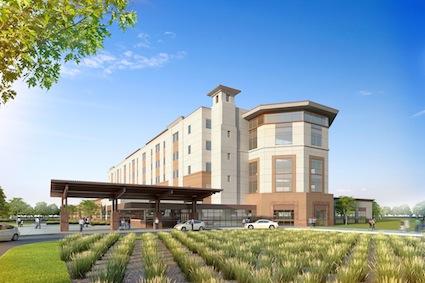Applying Lean Principles at Temecula Valley Hospital

When Universal Health Services (UHS) looked to build a new greenfield hospital in Temecula, Calif., they were challenged to do more with less. They set forth on a journey to design and construct a 140-bed acute care hospital with their pencils sharpened — a mere $144 million budget.
With construction costs on the rise, and hospitals being increasingly more expensive to build — most hospitals in California now cost nearly $2 million per bed — inefficiencies equate to dollars lost. At Temecula Valley Hospital, a groundbreaking process based on Lean principles is making it one of the fastest, and most cost-effective to construct hospitals brought to market in California.
The project, currently under construction, is based on a number of conditions of satisfaction set forth by the entire team, including being one of the safest and most patient-centered care environments — as well as one of the most operationally efficient —I n the entire UHS system. Crucial to this success, was the adoption of Lean principals. This method allows the owner, architect, and contractor to participate in the design and decision-making process from the onset of the project.
“Traditionally, project delivery systems create silos, where designers and contractors put personal or company goals ahead of the project,” says Bill Seed, Staff Vice President for Design and Construction for UHS. “This type of collaboration resulted in an accelerated construction timeline and reduced costs,” he adds.
First introduced in Japan with the Toyota Production System, the Lean approach serves as a framework for continuous performance improvement. The goal is to achieve operational and financial excellence, which includes best cost, quality, efficient delivery, empowered employees, and a consumer-focused culture. When applied to healthcare construction, this process is all about preserving value while eliminating waste, and it begins with the right team.
Comprised of HMC Architects, DPR/Turner, Southland Industries, and Bergelectric, the integrated project delivery team is utilizing target value design to drive toward the $144 million total project cost for the 140-bed hospital. According to the Lean Construction Institute (LCI), in lean construction, collaboration beginning early in design is extremely important. Everyone becomes a stakeholder in the project and is held accountable.
At Temecula Valley Hospital, this collaboration took place early on in what the team refers to as “The Big Room,” an off-site meeting room where weekly meetings are held with the entire project team present. Here, the team is able to discuss timely issues and problems are solved. “The combination of collaborative thinking, co-location, and transparency of costs are the key elements for establishing a lean design team,” says Seed. “We’re on target to meet all of our cost estimates. This will be one of the lowest cost new hospitals to built in California, coming in nearly half the costs of a hospital of similar size and program.”
The shared commitment of the project team drives many innovations, including financial incentives. At Temecula Valley Hospital, Lean principles drove the development of a contract that reflected shared goals and performance metrics. In this structure, the team has an incentive to beat the established project schedule and budget goals, which results in shared profits for everyone involved. Here, the DPR-Turner Construction team agreed to deliver the project at a specific cost and a specific schedule. When the team meets those objectives, they are rewarded. Every dollar saved by wasting translates to shared cost savings. On the other hand, if the team goes over budget, they stand to lose.
While on the surface, Lean principles seem largely about eliminating waste, they also add much to the design process. At Temecula, this process led to improved functionality and operational efficiency that will save the client long-term costs throughout the life of the facility. In the Consolidated Treatment Unit, for example, cost, effort, time, and operations efficiencies were gained. “At Temecula Valley, diagnostic services and other patient needs are met with the patient remaining in one place and services brought to them, which is not your typical model, where often departments are silo-based and patients go from place to place,” says Seed. “These types of operational strategies will prove to yield long-term cost savings over the life of the hospital. The benefits accrue back to us in better service, healthier patients, and a happier staff.”
As in life, in Lean construction nothing will ever be perfect. However, there is a continuous improvement process that will take place to create further value for our clients, their clients, and eliminate waste while creating improvements and innovation.

